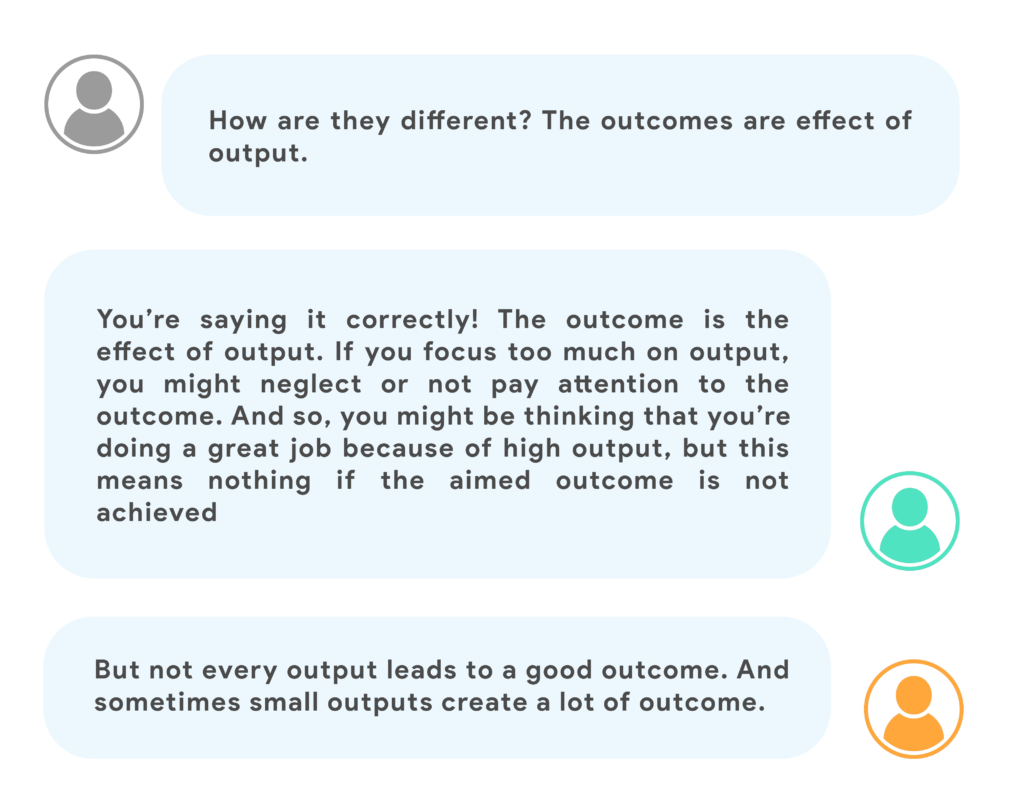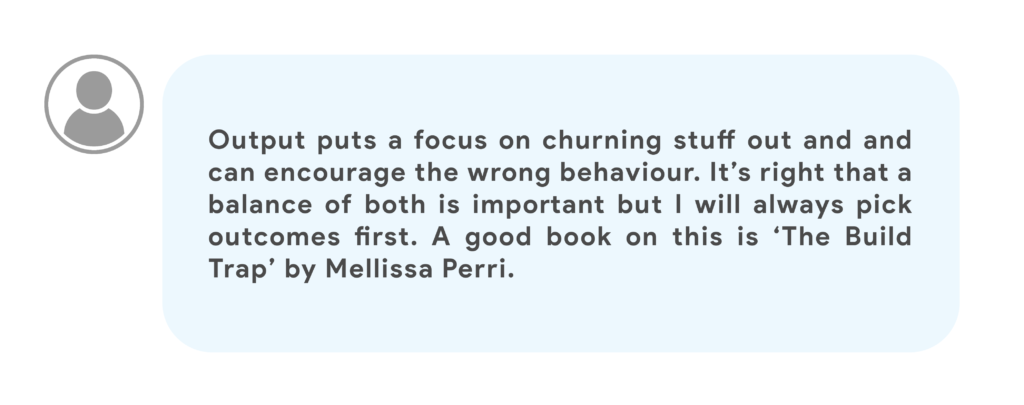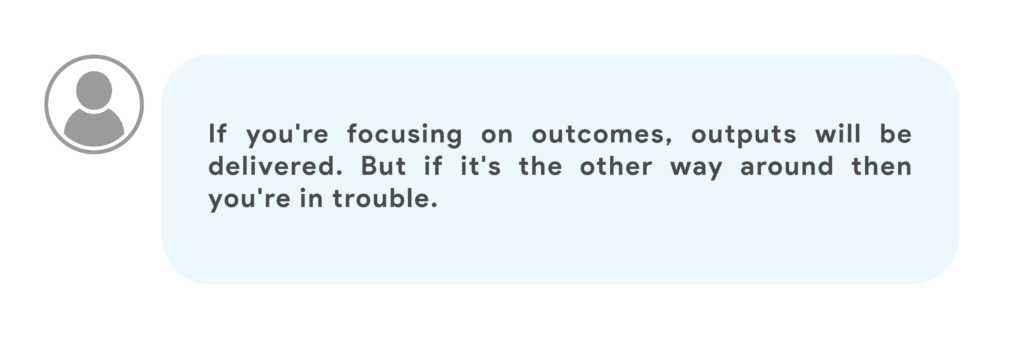Updated: January 24, 2024 - 9 min read
We all recognize the words ‘outcome’ and ‘output,’ and we all think we know what they means. But pit them against each other in ‘outcomes vs outputs,’ hand them over to the Product Management community, and suddenly there are some disagreements!
If you’re someone who builds a product or products, and makes high-level strategic product decisions…this is something you need to be thinking about. Are the decisions you make output focused, or outcome focused?
Here, we’re going to go into:
What does Outcomes over Outputs mean?
How can we define an outcome?
The value of OKRs and what they have to do with the debate
The Benefits of an outcome-centric approach for Product Management teams
Why more businesses aren’t more outcome focused
What our community of product people has to say
What Does Outcomes over Outputs Mean?
Outcome and output are easy enough terms to understand, but in business they are sometimes used interchangeably, causing a bit of confusion. Let’s start by breaking outcomes and outputs into the simplest terms possible, so we’re all on the same page on the meaning behind these two words.
Let’s imagine you’re on your way to work and feeling exhausted, so you go into the cafe next to the office and buy yourself an enormous coffee to get you through the morning.
To some people, the outcome of this event is the coffee, and the output was you walking into the shop to buy it. In business, the coffee could be your product and the output is the conglomeration of all the work you put into making it. And that’s where some people have been going wrong.
The outcome is not the coffee. The outcome is that you feel more energized by the caffeine boost and have a more productive morning. The outcome is the way in which your problem was solved by the output; the coffee.
How Can We Define an Outcome?
In business, defining an outcome isn’t as simple as feeling a caffeine boost. The outcome will be influenced by your mission, business goals, and targets. That’s a lot of weight for one word to carry!
In the knowledge economy, the concept of outcomes in business has changed dramatically. In a lot of ways, for businesses with digital products, users are part of the product. In an old fashioned assembly line, let’s say for a Model T Ford, the output and the outcome are the same. The factory wants to output X number of cars in a day, and the outcome they’re aiming for is to make X number of cars.
But if you think about it, Uber doesn’t actually own any cars. So what’s the outcome that they’re hoping for? If the app is the output, the outcome is the fleet of users (both drivers and passengers) which is essential to the business.
A useful exercise in understanding the outcomes of a modern-day business, particularly in Silicon Valley, is to examine companies in this way.
Spotify, as a music-streaming platform, doesn’t actually make music. The output is the platform (app and website), and the outcome is an engaged user base who have shifted their entire music collection over to Spotify. Another outcome, is that artists and podcasters large and small have a place to host and monetize their work.
Airbnb doesn’t own properties, instead it has a platform for people to advertise and rent short-term accommodation. They also have Airbnb Experiences to help foster a sense of community, and having an ‘off the beaten path’ travel experience that lets you connect with local people. The outcome is a loyal travel community, and a source of income for those with a spare bedroom.
Defining the outcome for your product and implementing it
If you’re now sat there asking yourself, ‘well, what’s the outcome for my product?’ there’s no need to panic. As a Product Manager/Product Owner, you are the keeper of the product vision. If you have that, then you already have your outcome.
Go back to your North Star, and thinking about why you want to build what you’re building. It can be easy to get stuck, focusing on the minutiae of product development instead of remembering your reason why.
As Josh Seiden states in Harvard Business Review,
““The old cliché in marketing is true: Customers don’t want a quarter-inch drill. They want a quarter-inch hole. In other words, they care about the end result, and don’t really care about the means. The same is true of managers: They don’t care how they achieve their business goals; they just want to achieve them.””
Instead of focusing on how to make a better and better drill, build your product strategy around how to help people achieve that quarter-inch hole.
In practice, this might mean dedicating more resources to your onboarding process to make sure users actually know how to use your product. You might have built them the most wonderful drill in the world, but the output is useless if nobody actually understands how to work it.
It might also involve working more closely with your designers to make sure the user experience is designed in a way that will delight customers, as well as being functional, if your goal is to foster a loyal customer base who repeatedly choose you over competitors.
The Value of OKRs
If you’ve been implementing OKRs for your product/teams, then you’ve already adopted the mindset shift from output-based to outcome-based.
If you need to refresh your knowledge of OKRs, check out this quick guide!
OKRs are a valuable part of an outcome over output mindset. If you’ve already been implementing them, then you’ve already embraced the shift! By using OKRs you’ve already set the tone of focusing on the objective and working backwards from that.
To focus on outcomes, you should align your weekly/monthly/quarterly OKR objective with your desired outcome.
Why Aren’t More Businesses Outcome-Focused?
It’s very easy to say that we should all focus on outcomes, but the reality of applying that to our businesses practices is less simple. No methodology is without its downsides.
First of all, an outcome is less measurable and quantifiable than the output. Thinking back to our earlier example, it’s easy to look at a factory floor at the end of the day and say ‘we wanted 20 cars, and now we have 20 cars.’ But when your desired outcome is like Airbnb’s missions statement; “To live in the world where one day you can feel like you’re home anywhere & not in a home, but truly home, where you belong.” How would you start measuring that?! It’s much simpler to focus on what you’re doing day to day, than it is to look to the future.
You might also be interested in: Why Customers Come Back
In many companies there is also the usual pressure to move on to the next project almost as soon as the previous has reached completion. The idea of stopping to reflect on ‘how did we do?’ is still a fairly foreign concept, particularly in larger, more traditional companies.
The Benefits of an Outcome-Centric Approach
1. Flexibility
When you start with the outcome you want first, that gives you a significant amount more freedom and flexibility in your approach to reaching that outcome. As opposed to setting the output first and hoping that it will lead you to your desired outcome.
You may have heard the expression ‘kill your darlings, ‘ which is a valuable lesson to learn in Product Management. There’s nothing worse than working incredibly hard on a product or feature, only for it to fail at the last hurdle. When you start with the outcome, and work your way towards it, consistently check in with yourself throughout development and ask ‘will this help to reach the outcome we need?’
You may also be interested in: Product-Led Growth Strategy for Product Managers
If the answer is no, then you have to go back a step and rethink. It can be painful, but preferable to using a lot of time and resources on something doomed to fail.
2. A clearer, more motivational goal
Often, it’s difficult for employees to care deeply about output. What motivates people to come to work every day isn’t the minute-by-minute tasks they get to do, it’s what those tasks will lead to.
When someone has been staring at spreadsheets and dashboards for hours on end, they’re not motivated by the idea of creating that report you’ve asked them for. Instead, they’re motivated by what that data analysis will lead to; a better product and a better outcome.
This approach aids communication between teams, particularly when going between marketing, sales, and engineering teams. Don’t just command your teams to do something, tell them what the end goal is so that they understand the why behind each decision. It’ll help make things like alignment over product roadmap and prioritization decisions much easier to achieve.
Using an outcome-focused management style with your development teams will help to keep them motivated, and nothing drives business results quite like an excited and motivated team! It’s a long-term investment that’ll pay off time and time again with each product release.
3. More customer focused
One of the main practices of being an outcome-focused Product Manager, is to keep caring about the product after launch. Many product people say that after launch is when the real work begins, as you start analyzing usage data, gathering customer feedback, and thinking about iteration.
When you’re focused on the outcome, you naturally pay more attention to what customers have to say about your product. How it makes them feel, what they like and don’t like about it, and how the overall experience could be improved. Investing this time in understanding your users after you’ve already taken your product to market will be invaluable.
Being outcome-focused also means taking this feedback into account throughout the entire product development, perhaps by launching an MVP or MLP.
What the Community Says
We asked our community on Facebook what they thought and whether Product Managers should focus on outcomes over outputs. Here’s what they had to say. (See the full thread by joining the group here.)




Final Thoughts: Why Choose Outcomes?
As a Product Manager, you are responsible for the outcome of a product, not the output. No one is going to care how many user personas you came up with or how many interviews were conducted if the final product doesn’t solve the problem.
Of course, there is no outcome without the output! It’s important to take care with both, and find the balance.
Updated: January 24, 2024
